What Are The Different Types of Resume Formats?
February 29, 2024You need to know what are the different types of resume formats so that you’re confident in what you’re using for your resume. Many resume writers have different types of resume formats that they use for clients. Once you’ve had your resume written a few times by writers, you’ll see a common trend occurring. They will resemble 1 of these 5 formats that we’re going to be diving in.
We’re going to go over what are the different types of resume formats, how different types of resume formats are written, and what goes into them.
You’ll also see how we review resume formats and determine whether or not what’s good.
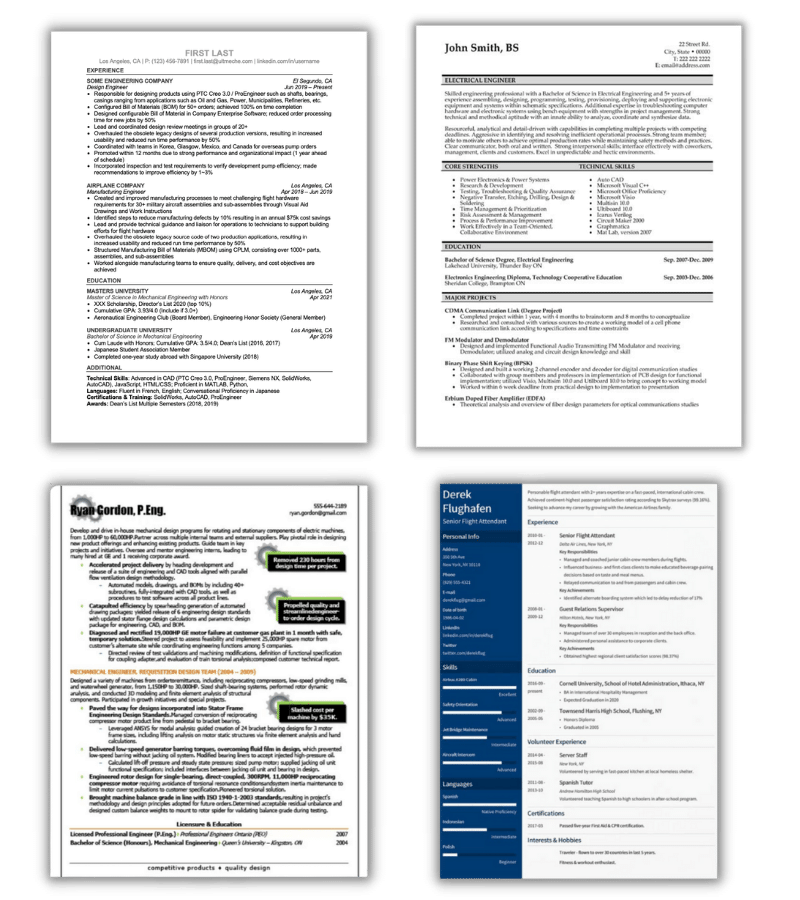
Which one of these would you use? Why?
What are the different types of resume formats?
Format 1 – The Standard “Wall Street” Resume Format
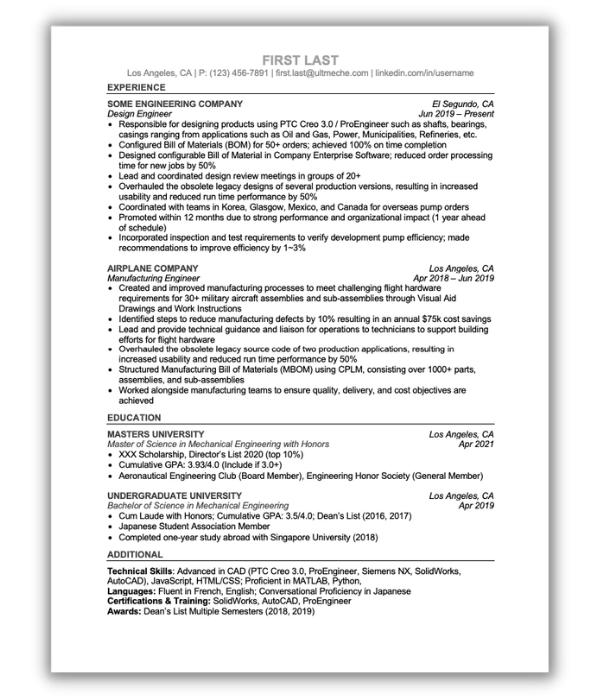
This is the number one format we recommend, we’re calling it “The Standard Wall Street Resume Format”
If you look at resumes submitted across the board, they will most likely resemble this type of format.
The headings such as Experience, Education, and Additional are all left aligned and separated by a border. Underneath each heading consists of employers, colleges, or specific skills.
This is the most common type of format you’ll see.
The format that we’re showing here uses Arial font – which gives the format a clean, crisp look.
Want to see boring and generic? Take Format 1 and switch the font to Times New Roman.
You’re going to be disgusted by how old fashioned that looks.
Experience
In a standard format, each experience with an employer should be laid out with:
- Company Name
- Job Title
- City, ST
- Years of Service
- Bullet points detailing keywords & quantitative results and accomplishments
This is what recruiters are trained to look at and scan very quickly.
Education
Education should include:
- University Name
- Degree
- City, ST
- Year of graduation
- Additional relevant bullet points under university experience
Additional
The Additional section in a resume is where you need to capture everything else that you haven’t outside of your experience and education.
Some examples are:
- Technical Skills
- Programming Skills
- Languages (if relevant)
- Certifications & Training
- Awards
- Publications
- Presentations
In summary, this is the resume format you should be using for 99.99% of all job applications.
It’s simple, clear and concise, and to the point.
Format 2 – The “Old Fashioned” Bold Resume Format
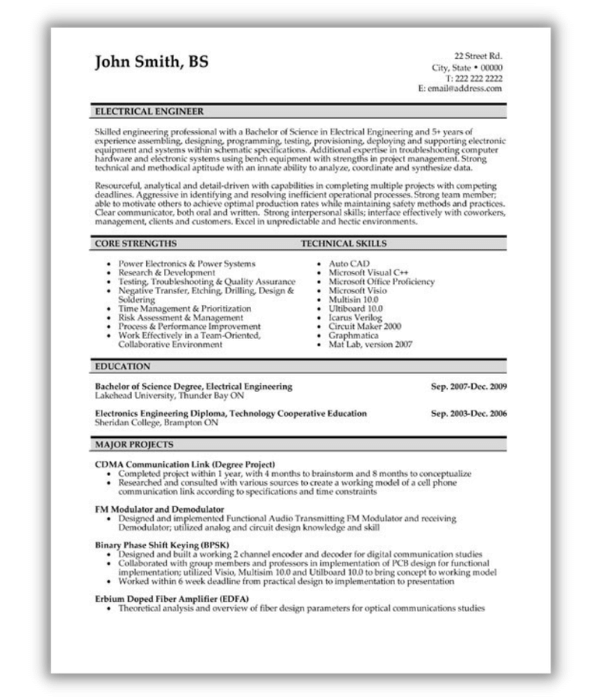
We call this the Old Fashioned Bold Resume Format.
Why?
Because look at it.
It looks very old fashioned, like it came out of the printing press times in the 1970’s.
The text does not look “clean” or “simple” and it’s difficult to parse in a 6 second time frame. A recruiter will only be able to read part of the summary before moving onto the next resume.
Summary
First of all, a summary section is redundant information in your resume. If done properly, the bulletpoints underneath your experience section should be the area where you summarize your experience.
The resume doesn’t even offer an Experience section – so keep on the look out for that when you’re trying to hire a resume writer.
Core Strengths
We do not recommend having a “Core Strengths” or “Core Competencies” section anywhere:
Phrases you do not include as a skill:
- Project Management
- Ability To Work In A Fast Paced Environment
- Ability To Multi-task effectively
- Problem Solving Skills
- Time Management Skills
- Work in a Team Environment
Why do we not include phrases such as core strengths or competencies?
Because anyone can put this on their resume. The fact that anyone can specify these phrases – “Problem Solving Skills” or “Ability to work in a fast paced environment” makes phrases such as these weaker keywords.
Instead you want to SHOW that you can Problem Solve or that you have the ability to work in a fast paced environment.
Show, don’t tell.
Use the STAR framework to create the bullet points on your resume.
Technical Skills
Technical Skills are laid out as bullet points in a column, this is fine, but we recommend listing technical skills all in the same line, similar to Format 1.
Education
Pretty standard formatting, but we call out the University as Bold instead of the degree – University carries a lot of weight in determining applicants.
Employers have a set of Colleges or Universities they like to hire from – insider tip.
Major Projects
It’s great that this resume has a “Projects” section.
Projects are the best way to showcase your experience if you don’t have experience. This is a great resume for someone who hasn’t started working and has no experience.
Engineering students need a portfolio of Projects that they can place on their resumes.
This is where they will place important items such as keywords and quantifiable results.
Format 3 – The “Modern Resume Format”
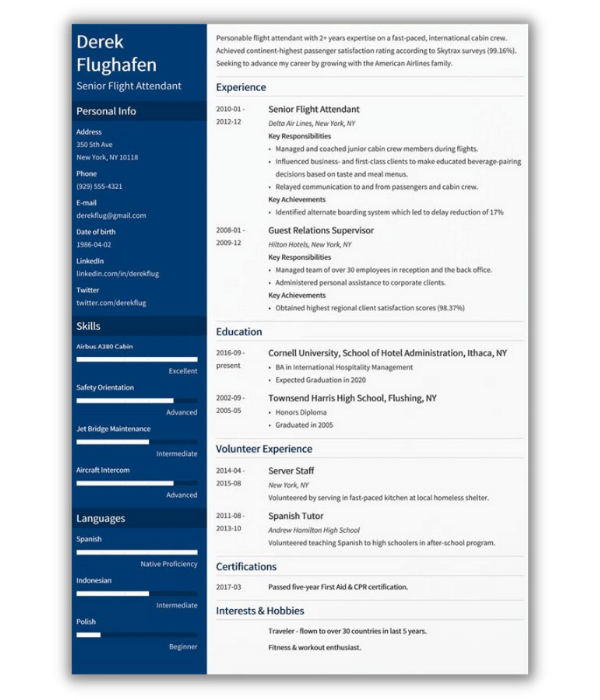
This right here is “The Modern Resume Template”.
It consists of a “block” of personal info, skills, languages (or something similar).
A lot of people like this type of format, but in our opinion, its an in-effective way to showcase your skills. You’re leaving a lot on the table if you use this format.
Just because simple and modern is the trend, no need to use a “trendy resume”.
Just use something that works.
No need to recreate the wheel with resume formats.
Left Block
So this is the type of format that separates between a “Left Block” and a “Right Block”
The Left Block consists of info such as:
- Personal Info
- Skills
- Languages
Personal Info
This is standard info to put and specify. Nothing wrong here.
Skills
This is a grey area – how do you qualitatively assess that you’re either intermediate, advanced, or excellent?
Do not qualitatively assess your skills on your resume.
You need to quantify your results and accomplishments.
If it can’t be measured, then was it really done?
Languages
I’m gonna have to say that unless the role requires literacy in a language, it’s completely unnecessary to put on your resume. Again, this format qualitatively assesses the language skills.
We do not recommend qualitatively assessing these skills ever.
Right Block
This is where the “Body” of the resume lies. You will see information here that you’ll see in a “Standard” resume format.
The very top of the Body starts with a professional summary – which is another item we do not recommend on resumes.
This format also leaves a lot of space all over – essentially leaving a lot on the table when it comes to framing your actual skills, results, and accomplishments.
Experience
The experience section is weak on this resume – there should be more than a few bullets (refer to Format 1)
Education
Education is called out in a standard manner in this resume format.
Volunteer Experience
Although volunteering experience looks good from a moral standpoint, it’s not as effective as stronger bulletpoints on your experience.
Certifications
This is relevant info – good to list relevant certifications on your resume.
As the example resume shown is for a flight attendant, being CPR certified is relevant.
Interests & Hobbies
Completely unnecessary to add an Interests & Hobbies section here.
Format 4 – The Over Designed Resume Format

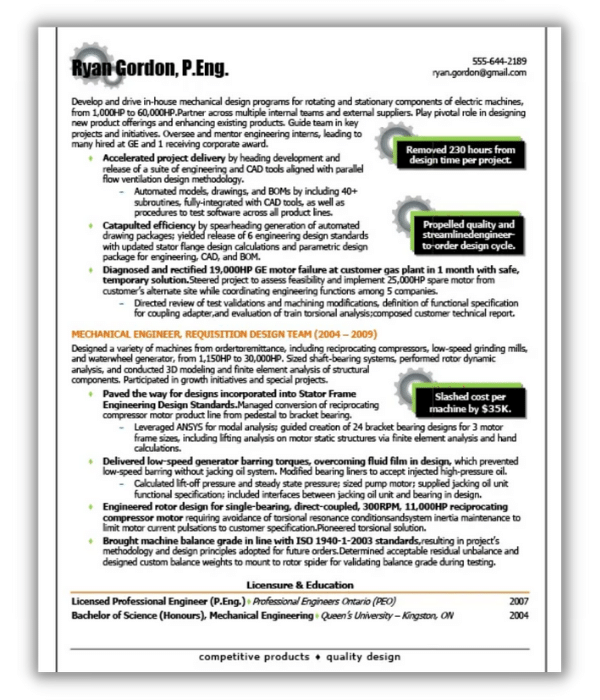
Ok, wow. This resume has got a lot going on. From colors, to borders, to shapes, and gears. Very visual for a mechanical engineering resume.
Unfortunately, there’s just way too much packed and it’s too hard to quickly scan through something like this for keywords.
And the resume is 2 pages long – does the resume really need all of this?
We disagree with the over designed approach.
The over designed resume is broken down into these sections:
- Summary
- Capabilities
- Career Progression
- Licensure & Education
Summary
We disagree with having a Summary – your skills should speak for itself. It’s a good way to capture years of experience (1, 5, 10, 15, etc.), but years of experience is already easy to gage just by looking at the years of service for employer.
Capabilities
Another way of saying “Skills”.
This resume does a good job of specifying engineering skills such as Structural Design, Machine Design, Rotor Dynamic Analysis, etc.
Career Progression
Fancy way of calling out “Experience”.
The resume uses indentations as sub-bullets underneath the main items under the experience section of the resume. This is another ineffective use of space. It gets way too in-depth on some of the engineering tasks that the person is responsible for.
Resumes should cover high-level items and as a result, resumes should only be one page. (There are exceptions to this though)
Format 5 – The Federal Resume Format
The Federal format is meaty – and is a resume SPECIFIC for US Federal positions. They require a lot of information from you when determining eligibility criteria for these positions:
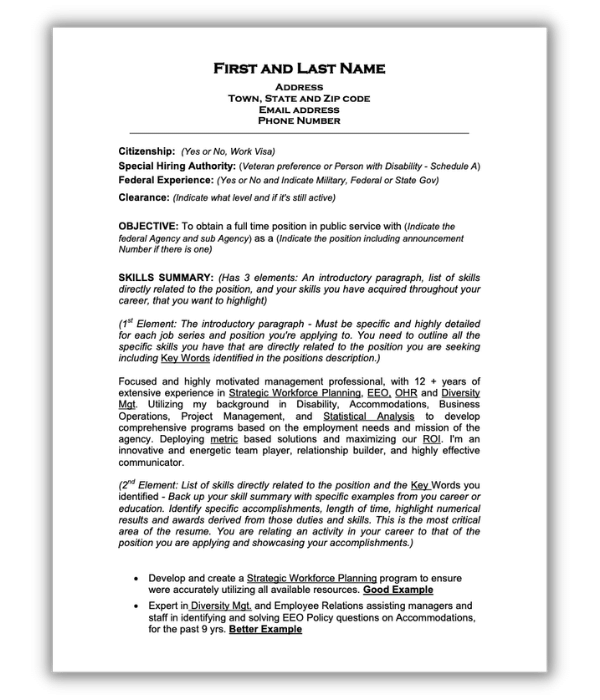
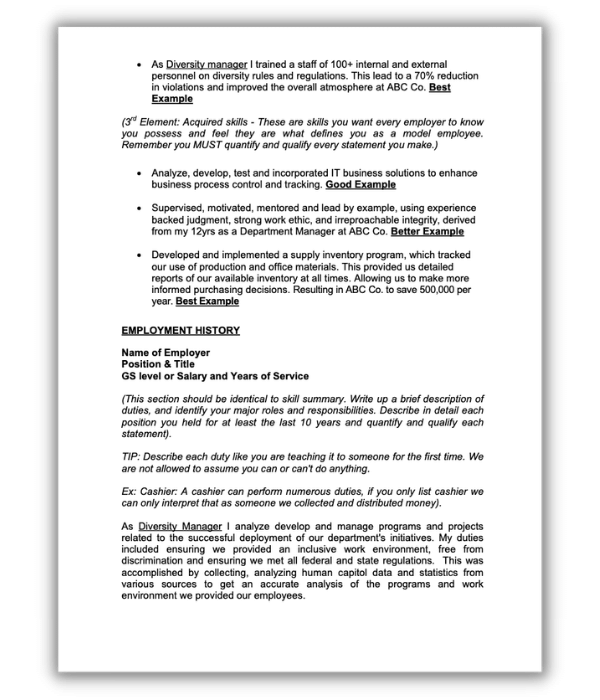
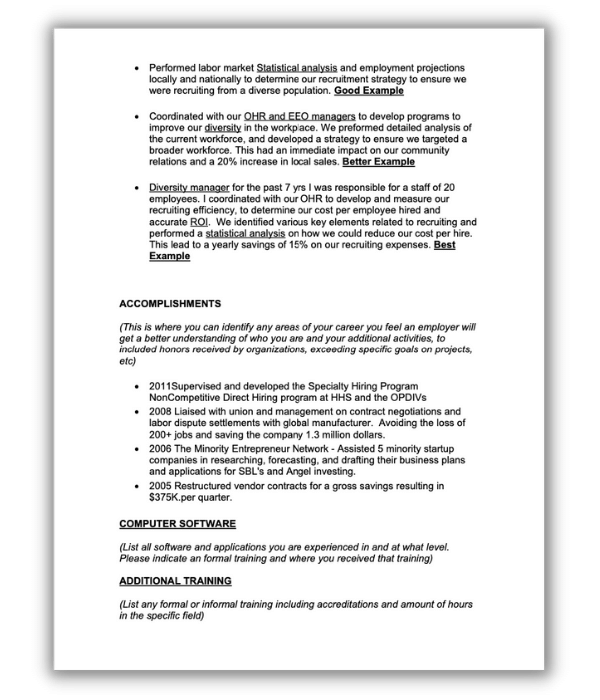
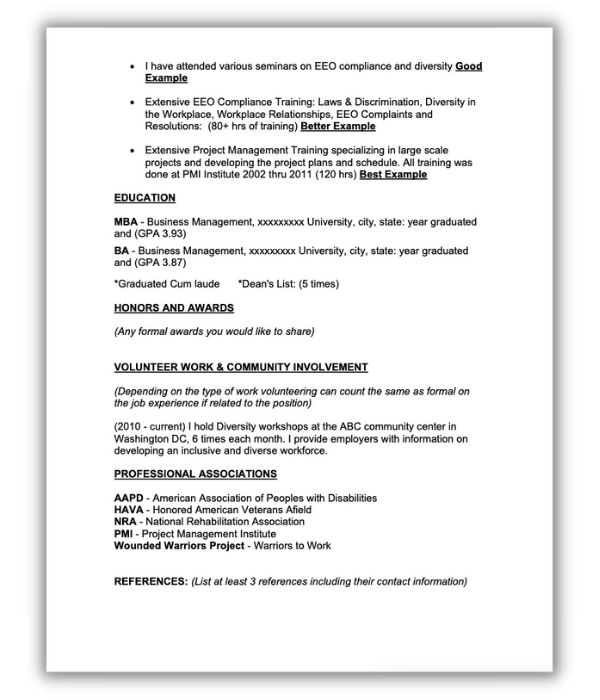
The Federal Resume Format is definitely in-depth.
US Government jobs undergo a lot of red-tape when it comes to processes, procedures, and basically how anything gets done.
This includes many requirements set in place for their resumes.
If you’re applying for a Federal job, you must use a Federal resume, no exceptions.
Your recruiter or the job application will mention this requirement to you.
See the images above for the specific requirements for Federal resumes – they’re spelled out pretty clearly.
Closing Thoughts
These 5 resumes should cover 99.99% of all scenarios, take your pick.
There are way more templates out there, but this covers what are the different types of resume formats for you from an overview standpoint.
We’ve covered the 5 types of resumes you’re likely to get when dealing with a resume service provider and break down the good and the bad.
About the author

Kazuyoshi Fujimoto, PE
Founder | Engineering Career Coach | Principal Mechanical Engineer
Kazu oversees all of ultmeche’s engineering services. He provides consulting such as resume reviews, rewrites, mock interviews, and all services career related. Additionally, Kazu performs consulting work regarding Oil & Gas, Automotive, and Aerospace & Defense. Kazu is licensed as a professional engineer in the state of California and has 9+ years of experience in Oil & Gas, Automotive, and Aerospace & Defense.
FAQ
Yes, these are actual formats that you will run into when looking at what are the different types of resume formats. Although they may be named something similar, at a high-level, resumes will look like 1 of the 5 resumes that we have outlined.
Use Format 1 – it’s clear and concise, displays quantitative results & accomplishments, and contains keywords. It’s also ATS Optimized.
You need to look for the following – Clarity and conciseness, ATS optimized, implementation of specific keywords relative to your job, and use of quantitative results and accomplishments.
Simple is best – the more information that you present, the more the recruiter is going to have to look at. This is not good. You want each piece of information to be important and relevant. Don’t include corporate fluff into your resume.
No – pictures, infographics, charts and the like on resumes will take too much of the focus away from the keywords. It’s an approach that is too over the top.
Federal jobs backed by the US Government have a lot of requirements that they need to ensure the candidate meets. Government work is ran by processes and procedures, and as a result, they require formatting in a specific way for Federal jobs.
